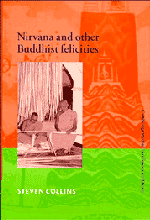Book contents
- Frontmatter
- Contents
- Preface and acknowledgments
- List of abbreviations
- Textual chronology
- General introduction: Buddhism and civilizational history 1 – structures and processes
- PART 1 NIRVANA IN AND OUT OF TIME
- PART 2 PARADISE IN HEAVEN AND ON EARTH
- Introduction to part 2: utopia and the ideal society
- 4 Heaven, the land of Cockaygne and Arcadia
- 5 Millennialism
- 6 The perfect moral commonwealth? Kingship and its discontents
- 7 The Vessantara Jātaka
- Conclusion to part 2: in what sense can one speak of Buddhist utopianism?
- General conclusion: Buddhism and civilizational history 2 – reprise
- Appendices (translated texts)
- Bibliography
- Glossary and index of Pali and Sanskrit words
- Name index
- Subject index
Introduction to part 2: utopia and the ideal society
Published online by Cambridge University Press: 18 December 2009
- Frontmatter
- Contents
- Preface and acknowledgments
- List of abbreviations
- Textual chronology
- General introduction: Buddhism and civilizational history 1 – structures and processes
- PART 1 NIRVANA IN AND OUT OF TIME
- PART 2 PARADISE IN HEAVEN AND ON EARTH
- Introduction to part 2: utopia and the ideal society
- 4 Heaven, the land of Cockaygne and Arcadia
- 5 Millennialism
- 6 The perfect moral commonwealth? Kingship and its discontents
- 7 The Vessantara Jātaka
- Conclusion to part 2: in what sense can one speak of Buddhist utopianism?
- General conclusion: Buddhism and civilizational history 2 – reprise
- Appendices (translated texts)
- Bibliography
- Glossary and index of Pali and Sanskrit words
- Name index
- Subject index
Summary
UTOPIA AND THE IDEAL SOCIETY
This Introduction does two things: first, two qualifications are made to what has been said previously about Buddhist thought and imagery, both of which bring the ultimate felicity of nirvana closer to other kinds of imaginatively efficient felicity than would seem to be possible given the logically discrete categories of the conditioned and the Unconditioned; second, it briefly introduces the categories of ideal society in the work of the historian J. C. Davis, which I use to organize these imaginatively efficient utopias.
Chapter 1.2.b, apropos the skillfulness of the enlightened person, made a clear distinction between the evaluation of action in terms of merit (puñña) and in terms of what is skillful or wholesome (kusala), arguing (after Premasiri 1976) that whereas the acquisition of merit through good action by an unenlightened person, done necessarily with some degree of attachment, entails (good) rebirth, the skillful action of an enlightened person, done without attachment, does not. Thus an enlightened person can be said to do “good” in the latter sense, but not in the former. But as was remarked there (pp. 154 n. 54), this distinction, while clearly discernible in texts of systematic thought, tends to diminish to vanishing point in others, particularly narratives.
- Type
- Chapter
- Information
- Nirvana and Other Buddhist Felicities , pp. 289 - 296Publisher: Cambridge University PressPrint publication year: 1998

